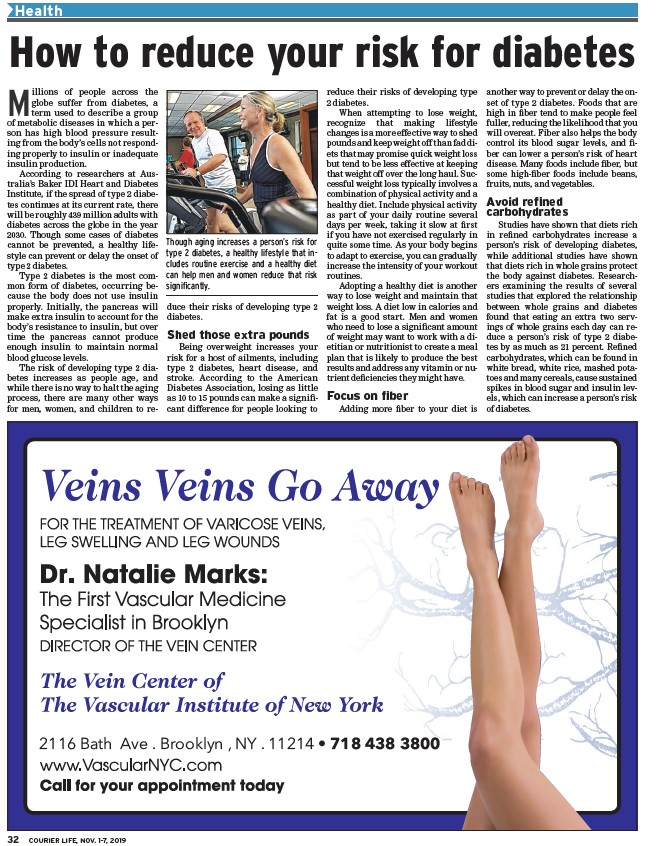
Health
How to reduce your risk for diabetes
Millions of people across the
globe suffer from diabetes, a
term used to describe a group
of metabolic diseases in which a person
has high blood pressure resulting
from the body’s cells not responding
properly to insulin or inadequate
insulin production.
According to researchers at Australia’s
Baker IDI Heart and Diabetes
Institute, if the spread of type 2 diabetes
continues at its current rate, there
will be roughly 439 million adults with
diabetes across the globe in the year
2030. Though some cases of diabetes
cannot be prevented, a healthy lifestyle
can prevent or delay the onset of
type 2 diabetes.
Type 2 diabetes is the most common
form of diabetes, occurring because
the body does not use insulin
properly. Initially, the pancreas will
make extra insulin to account for the
body’s resistance to insulin, but over
time the pancreas cannot produce
enough insulin to maintain normal
blood glucose levels.
The risk of developing type 2 diabetes
increases as people age, and
while there is no way to halt the aging
process, there are many other ways
for men, women, and children to reduce
2116 Bath Ave . Brooklyn , NY . 11214 • 718 438 3800
COURIER L 32 IFE, NOV. 1-7, 2019
their risks of developing type 2
diabetes.
Shed those extra pounds
Being overweight increases your
risk for a host of ailments, including
type 2 diabetes, heart disease, and
stroke. According to the American
Diabetes Association, losing as little
as 10 to 15 pounds can make a signifi -
cant difference for people looking to
reduce their risks of developing type
2 diabetes.
When attempting to lose weight,
recognize that making lifestyle
changes is a more effective way to shed
pounds and keep weight off than fad diets
that may promise quick weight loss
but tend to be less effective at keeping
that weight off over the long haul. Successful
weight loss typically involves a
combination of physical activity and a
healthy diet. Include physical activity
as part of your daily routine several
days per week, taking it slow at fi rst
if you have not exercised regularly in
quite some time. As your body begins
to adapt to exercise, you can gradually
increase the intensity of your workout
routines.
Adopting a healthy diet is another
way to lose weight and maintain that
weight loss. A diet low in calories and
fat is a good start. Men and women
who need to lose a signifi cant amount
of weight may want to work with a dietitian
or nutritionist to create a meal
plan that is likely to produce the best
results and address any vitamin or nutrient
defi ciencies they might have.
Focus on fi ber
Adding more fi ber to your diet is
another way to prevent or delay the onset
of type 2 diabetes. Foods that are
high in fi ber tend to make people feel
fuller, reducing the likelihood that you
will overeat. Fiber also helps the body
control its blood sugar levels, and fi -
ber can lower a person’s risk of heart
disease. Many foods include fi ber, but
some high-fi ber foods include beans,
fruits, nuts, and vegetables.
Avoid refi ned
carbohydrates
Studies have shown that diets rich
in refi ned carbohydrates increase a
person’s risk of developing diabetes,
while additional studies have shown
that diets rich in whole grains protect
the body against diabetes. Researchers
examining the results of several
studies that explored the relationship
between whole grains and diabetes
found that eating an extra two servings
of whole grains each day can reduce
a person’s risk of type 2 diabetes
by as much as 21 percent. Refi ned
carbohydrates, which can be found in
white bread, white rice, mashed potatoes
and many cereals, cause sustained
spikes in blood sugar and insulin levels,
which can increase a person’s risk
of diabetes.
Though aging increases a person’s risk for
type 2 diabetes, a healthy lifestyle that includes
routine exercise and a healthy diet
can help men and women reduce that risk
signifi cantly.